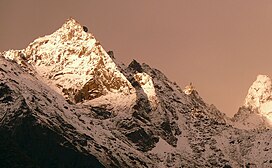
Mount Kailash is a mountain in Ngari Prefecture, Tibet Autonomous Region of China. It lies in the Kailash Range of the Transhimalaya, in the western part of the Tibetan Plateau. Mount Kailash is less than 100 km north of the western trijunction of the borders of China, India, and Nepal.

Kinnaur district is one of the twelve administrative districts of the state of Himachal Pradesh in northern India. The district is divided into three administrative areas and has six tehsils. The administrative headquarters of the district is at Reckong Peo. The revered Kinnaur Kailash mountain, one of the Panch Kailash sites, is situated in Kinnaur. As of 2011, it is the second least populous district of Himachal Pradesh, after Lahaul and Spiti.
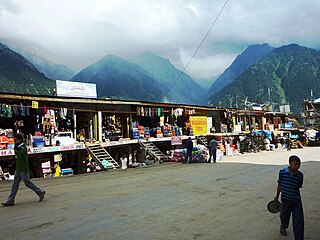
Reckong Peo, also spelled Rekong Peo or simply known as Peo by the local inhabitants, is headquarters of Kinnaur district, one of the twelve administrative districts of the Indian state of Himachal Pradesh.

Om Parvat a mountain located on the border of Darchula District, Nepal and Pithoragarh district, Uttarakhand, India Om Parvat peak elevation is 5,590 m (18,340 ft) above sea level. It is reached by the paved motorable Pithoragagh-Lipulekh Pass Highway (PLPH), via a spur along glaciated rivulet to Om Parvat from Nabhidhang. Route to Adi Kailash, from the forks at Gunji, goes northwest via Kuthi Valley along the Kuthi Yankti river. Mount Kailash in Tibet can be viewed from India from the Old Lipulekh Pass which lies northeast of Gunji and the Limpiyadhura Pass which lies northwest of Gunji.

Kalpa is a small village in the Sutlej river valley, above Reckong Peo in the Kinnaur district of Himachal Pradesh, Northern India, in the Indian Himalaya. The region is inhabited by the Kinnauri people and is known for its apple orchards, as apples are a major cash-crop for the region. The local Kinnauri follow a syncretism of Hinduism and Buddhism, and many temples in Kalpa are dedicated to both Hindu and Buddhist gods and goddesses. The average literacy rate of Kalpa is around 83.75%. India's first ever voter, Shyam Saran Negi, also belongs to Kalpa.

Manimahesh Lake is a high altitude lake situated close to the Manimahesh Kailash Peak in the Pir Panjal Range of the Himalayas, in the Bharmour subdivision of Chamba district of the Indian state of Himachal Pradesh. The religious significance of this lake is next to that of the Lake Manasarovar in Tibet.
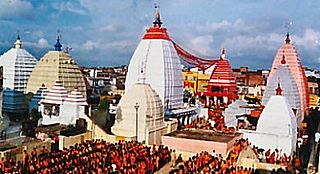
The Baidyanath Temple, also called Baba Baidyanath Dham, is a Hindu temple dedicated to Shiva. It is located in Deoghar, in the Santhal Parganas division of the Indian state of Jharkhand.

Sacred mountains are central to certain religions, and are usually the subjects of many legends. For many, the most symbolic aspect of a mountain is the peak because it is believed that it is closest to heaven or other religious realms. Many religions have traditions centered on sacred mountains, which either are or were considered holy or are related to famous events. In some cases, the sacred mountain is purely mythical, like the Hara Berezaiti in Zoroastrianism. Mount Kailash is believed to be the abode of the deities Shiva and Parvati, and is considered sacred in four religions: Hinduism, Bon, Buddhism, and Jainism. Volcanoes, such as Mount Etna in Italy, were also considered sacred, Mount Etna being believed to have been the home of Vulcan, the Roman god of fire and the forge.

Patal Bhuvaneshwar is a limestone Hindu cave temple 14 km from Gangolihat in the Pithoragarh district of Uttarakhand state in India. It is located in the village of Bhubneshwar. Legend and folklore have it that this cave enshrines Lord Shiva and thirty three koti demigods [33 types and not crore]. The cave is 160 m long and 90 feet deep from the point of entrance. Limestone rock formations have created various spectacular stalactite and stalagmite figures of various hues and forms. This cave has a narrow tunnel-like opening which leads to a number of caves. The cave is fully electrically illuminated. Built by the flow of water, Patal Bhuvaneshwar is not just one cave, rather a series of caves within caves.
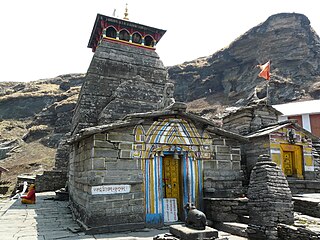
Tungnath (IAST:tuņgnāth) is one of the highest Shiva temples in the world and is the highest of the five Panch Kedar temples located in the Rudraprayag district, in the Indian state of Uttarakhand. The Tungnath mountains form the Mandakini and Alaknanda river valleys. It is located at an altitude of 3,690 m (12,106 ft), and just below the peak of Chandrashila. It has a rich legend linked to the Pandavas, heroes of the Mahabharata epic.

The Velliangiri Mountains a part of the Nilgiri Biosphere Reserve are situated at the Western Ghats of Coimbatore district, Tamil Nadu. Known as the "Sapthagiri, 7 Hills - Seven Mountains", these mountains are held and revered on par with spiritually most powerful place on the planet - Mount Kailash, the legendary abode of Shiva. On the top of the Velliangiri Mountains, Shiva is worshipped as Swayambhu, one who is self-created and in this form, he graces the devotees.

The Manimahesh Kailash Peak, 5,653 metres (18,547 ft), also known as Chamba Kailash, which stands towering high over the Manimahesh Lake, is believed to be the abode of Lord Shiva, the Hindu deity. It is located in the Bharmour subdivision of the Chamba district in the Indian state of Himachal Pradesh. It is the fifth most important peak among the group of five separate peaks in Himalayas in separate locations collectively known as the Panch Kailash or "Five Kailashas", other being Mount Kailash in first place, Adi Kailash in second, Shikhar Kailash in third, and Kinnaur Kailash in fouth place in terms of importance. The peak is 26 kilometres (16 mi) from Bharmour in the Budhil valley. It is one of the major pilgrimage sites as well as a popular trekking destination in Himachal Pradesh. The Manimahesh Lake is at the base of the Kailash peak at 3,950 metres (12,960 ft) and is also held in deep veneration by people of Himachal Pradesh, particularly the Gaddi tribe of the region. In the month of Bhadon, on the eighth day of the new moon period a fair is held in the precincts of the lake that attracts thousands of pilgrims.
Uttarakhand is a state in the northern part of India. It is often referred to as the "Devbhumi" due to its religious significance and numerous Hindu temples and pilgrimage sites found throughout the state. As a result, religious tourism forms a major portion of the tourism in the state. Uttarakhand is known for the natural environment of the Himalayas. 2019 Tourist Arrivals Domestic – 40,000,000 per/year and Foreigner – 150,000 per year. Tourism business in Uttarakhand generated ₹ 23,000 crores during 2013–14.

Ravananugraha or Ravananugraha-murti is a benevolent aspect of the Hindu god Shiva, depicted seated on his abode Mount Kailash with his consort Parvati, while the rakshasa-king (demon-king) Ravana of Lanka attempts to uproot it. According to Hindu scriptures, Ravana once tried to lift Mount Kailash, but Shiva pushed the mountain into place, and trapped Ravana beneath it. For a thousand years, the imprisoned Ravana sang hymns in praise of Shiva, who finally blessed him and granted him an invincible sword and a powerful linga to worship. The theme is popular in Indian art and is found as early as the Gupta-Pallava era.
Piramanoor Shree Kailasha Nathar Temple is an ancient Shiva temple(now under renovation) in Piramanoor, a village in Tiruppuvanam Taluk, Sivaganga district, Tamil Nadu, India.
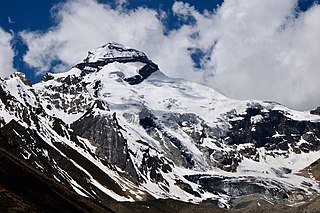
Adi Kailash, also known as Shiva Kailash, Chota Kailash, Baba Kailash or Jonglingkong Peak, is a mountain located in the Himalayan mountain range in the Pithoragarh district of Uttarakhand, India. It is the second most important peak among the group of five separate peaks in Himalayas in separate locations collectively known as the Panch Kailash or "Five Kailashas", other being Mount Kailash in first place, Shikhar Kailash in third, Kinnaur Kailash in fourth and Manimahesh Kailash in fifth place in terms of importance. Gauri Kund and Parvati Tal glacial lakes are at the base of the Adi Parvat. Adi Kailash & Limpiyadhura Pass are both located northwest of Gunji. The Lipulekh Pass, Old Lipulekh Peak & Om Parvat are located northeast of Gunji. Adi Kailash base camp, near the Hindu Shiva temple on the banks of sacred Jolingkong Lake, is located 17 km northwest of Kuthi (Kuti) village in Kuthi Yankti Valley. The Adi Kailash Yatra Circuit route-1 via Gunji, the eastern-southeastern route, is reached by the Pithoragagh-Lipulekh Pass Highway (PLPH) and its Gunji-Lampiya Dhura Pass Road (GLDPR) paved motorable spur via Kuthi Yankti Valley from Gunji to Adi Kailash. The permits for this route are issued at Dharchula and medical check-up is conducted there. The homestay accommodation is available in the villages along the route in Gunji, Napalachchu, Nabhi, Juli Kong and Kuti. The Adi Kailash Yatra Circuit route-2 via Darma Valley, the western-southwestern route, begins by going up the Darma Valley and then crossing the Sin La pass south of Brahma Parvat to go to Kuthi Yankti Valley to Jolingkong Lake Base Camp. Many travellers who take the route-2, after the Adi Kailash darshan chose to traverse the route-1 in reverse direction till Gunji where they can join the Om Parvat & Mount Kailash-Lake Manasarovar Tibetan pilgrimage route along the Sharda River. Kailash-Mansarovar, Adi Kailash and Om Parvat are sacred to Hindus.

Shrikhand Mahadev Kailash, also called Shikhar Kailash, is a Hindu pilgrimage site in Kullu, Himachal Pradesh, India, considered to be an abode of Lord Shiva and his wife Goddess Parvati. It is considered to be one of the toughest treks in India. It is the third most important peak among the group of five separate peaks in Himalayas in separate locations collectively known as the Panch Kailash or "Five Kailashas", other being Mount Kailash in first place, Adi Kailash in second, Kinnaur Kailash in fouth and Manimahesh Kailash in fifth place in terms of importance. The 75 feet Shivalingam at the top of the Shrikhand Mahadev mountain is at a height of 18,570 feet.
Devi Adi Parashakti is a mythological television series based on the Hindu texts of the Shiva Purana, the Devi-Bhagavata Purana, the Markandeya Purana, and pan-Indian folktales of the Goddess. The series was created by Siddharth Kumar Tewary, directed by Loknath Pandey and Manish Singh, and produced by Swastik Productions. Rati Pandey plays the role of Devi Adi Parashakti and her incarnations Goddess Sati, and Goddess Parvati. Tarun Khanna played the role of Devi's husband, Lord Shiva with Kanan Malhotra as Lord Vishnu, Devi's brother. The show also features Sonia Singh as Goddess Diti, the main antagonist.
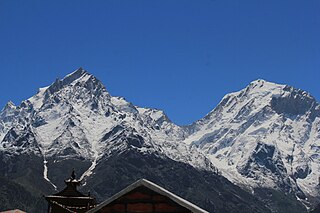
Jorkanden is a 6,473 metres (21,237 ft) high Himalayan peak in the Indian state of Himachal Pradesh. It is the highest peak in the Kinner Kailash range of the Greater Himalayas. An expedition team of the Indo-Tibetan Border Police first climbed the peak on 26 May 1974. The peak is often confused with the Kinnaur Kailash peak 6,050 metres (19,850 ft), which can be distinguished through its distinctly pointed 'pillar' on top, which is worshipped as a shivling, abode of the Indian god Shiva.
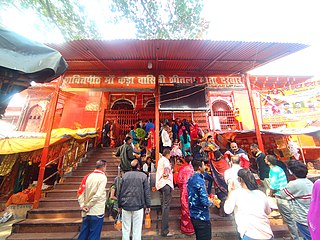
Sheetla Devi Temple is a Hindu temple dedicated to the mother goddess Shitala, located in Kara, a town located near Sirathu, on the banks of river Ganges in Kaushambi district of Uttar Pradesh. It is one of the 51 Shakti Peethas in Shaktism denomination of Hinduism. The deity of the temple is regarded as the Kuldevi of Purvanchal. It is also known as Kada Dham, Sheetlan and Sheetla Dham, Kada.
